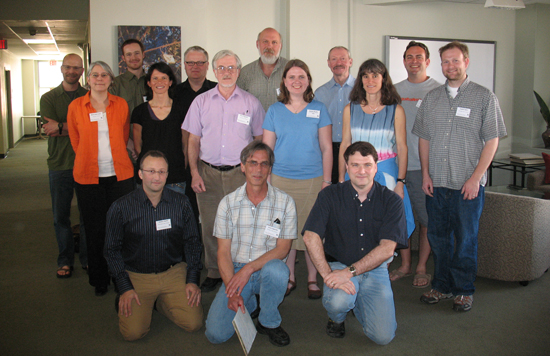NCEAS Working Groups
An interdisciplinary approach to advancing landscape genetics
Project Description
Spatial patterns of genetic variation reflect the way in which organisms move through the landscape, providing a means for understanding population connectivity. Landscape genetics is a nascent field that seeks to describe how landscape features such as mountains, streams and roads influence spatial-temporal processes of population genetics and the ultimate distribution of genetic variation. Whereas traditional ways of estimating population connectivity lack consideration of landscape features, landscape genetics provides the distinct benefit of facilitating tests of the influence of specific landscape variables on dispersal. As a result, landscape genetics holds great promise for ecological research and the development of conservation programs focused on landscape features that facilitate connectivity among populations. Recent advances in high-throughput collection of genetic data combined with increased availability of GIS-based landscape data have outpaced advances in statistical methods. In response to this need, we will bring together a diverse group of landscape ecologists, spatial analysts and population geneticists to: 1. examine the applicability of historic and currently used spatial tools for estimating genetic structure with modern molecular data 2. examine the statistical rigor of each combination of statistic and data to test hypotheses about underlying spatial-temporal processes 3. adapt existing and invent new methods for analyzing modern genomic data in a spatial context 4. develop forums for communicating with a broad spectrum of scientists.

Principal Investigator(s)
Michael S. Rosenberg, Bryan K. Epperson, Andrew T. Storfer
Project Dates
Start: March 18, 2009
End: February 22, 2011
completed
Participants
- Corey Anderson
- Arizona State University
- Michael F. Antolin
- Colorado State University
- Aurelie Bonin
- Université Joseph Fourier
- Mark Dale
- University of Northern British Columbia
- Bryan K. Epperson
- Michigan State University
- Marie-Josée Fortin
- University of Toronto
- Rolf Holderegger
- Swiss Federal Institute for Forest, Snow and Research (WSL)
- Patrick M. James
- University of Alberta
- Pierre Legendre
- Université de Montréal
- Stephanie Manel
- Université Aix-Marseille
- Jerome Mathieu
- University of California, Santa Barbara
- Brad H. McRae
- The Nature Conservancy
- Melanie A. Murphy
- Colorado State University
- Hugh P. Possingham
- Michael S. Rosenberg
- Arizona State University
- Noah Rosenberg
- University of Michigan
- Kim T. Scribner
- Michigan State University
- Stephen Spear
- University of Idaho
- Andrew T. Storfer
- Washington State University
- Helene H. Wagner
- University of Toronto, Mississauga
- Lisette Waits
- University of Idaho
Products
-
Journal Article / 2010
Considering spatial and temporal scale in landscape-genetic studies of gene flow
-
Journal Article / 2010
Spatial correlations at different spatial scales are themselves highly correlated in isolation by distance processes
-
Journal Article / 2010
Utility of computer simulations in landscape genetics
-
Journal Article / 2010
Comparison of the Mantel test and alternative approaches for detecting complex multivariate relationships in the spatial analysis of genetic data
-
Journal Article / 2010
Common factors drive adaptive genetic variation at different spatial scales in Arabis alpina
-
Journal Article / 2010
Perspectives on the use of landscape genetics to detect genetic adaptive variation in the field
-
Journal Article / 2012
Determinants of actual functional connectivity for calcareous grassland communities linked by rotational sheep grazing
-
Journal Article / 2010
Use of resistance surfaces for landscape genetic studies: Considerations for parameterization and analysis
-
Journal Article / 2010
Landscape genetics: Where are we now?
